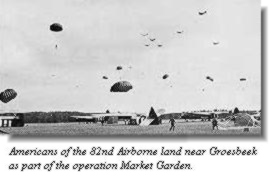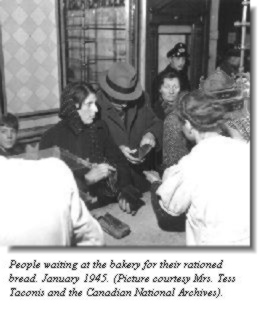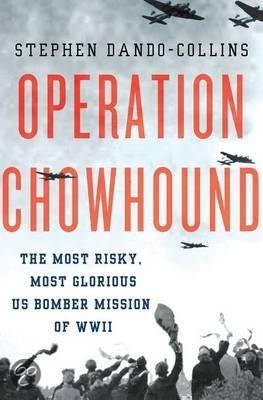THE HUNGER WINTER
 On September 17, 1944 the sky over southern Holland was filled with paratroopers. That sunny Sunday afternoon marked the beginning of operation "Market Garden". Field Marshall Montgomery had conceived a plan that would end the war in one quick blow. Three airborne divisions were ordered to grab hold of a number of bridges behind enemy lines and form a corridor from Belgium through Eindhoven, Nijmegen and finally to Arnhem where they had to grab the Bridge across the Rhine. The British ground forces had to follow and in one big hop bypass the Rhine. From there these ground forces had to turn right into the Ruhr, the industrial heart of Germany.
On September 17, 1944 the sky over southern Holland was filled with paratroopers. That sunny Sunday afternoon marked the beginning of operation "Market Garden". Field Marshall Montgomery had conceived a plan that would end the war in one quick blow. Three airborne divisions were ordered to grab hold of a number of bridges behind enemy lines and form a corridor from Belgium through Eindhoven, Nijmegen and finally to Arnhem where they had to grab the Bridge across the Rhine. The British ground forces had to follow and in one big hop bypass the Rhine. From there these ground forces had to turn right into the Ruhr, the industrial heart of Germany.
The plan was fantastic if it worked. In London everybody believed that the war would be over before the end of the year. The operation fitted in that picture. The Dutch government, convinced of a quick end of the war decided that the allied operation would be aided if they called for a railway strike in occupied Holland. This strike would seriously hamper German mobility and prevent a quick German counterattack in the early stage of the operation.
The strike became reality and the Dutch underground followed the orders with great enthusiasm. Within one single day the majority of the railroad personnel disappeared underground. All traffic by train stopped and the Germans had to get personnel from Germany to fill the gaps.
The bridge at Arnhem proofed to be the bridge too far and operation Market Garden failed. The Dutch saw themselves facing another winter under German occupation.
 The Germans hit back at the Dutch to make them pay for the railway strike. The transportation of food was seized completely, for six weeks. On September 27, the first signal from occupied Holland, that food was becoming a problem reaches London. The message mentions that there is only enough food left for several weeks. From that moment the rations get smaller and smaller.
The Germans hit back at the Dutch to make them pay for the railway strike. The transportation of food was seized completely, for six weeks. On September 27, the first signal from occupied Holland, that food was becoming a problem reaches London. The message mentions that there is only enough food left for several weeks. From that moment the rations get smaller and smaller.
Those that depended solely on the rations for food suffered from hunger from November on.
The people had to start looking for other ways to get food. The people in the rural parts of Western Holland could get enough food from what they grew in their own backyard, but for the people in the densely populated cities of Western Holland, the decline of the official rations posed serious problems.
Personal recollections of the hungerwinter:
John PapenhuyzenPieter van Marken
Jan van Atten
Continue with this chapter
The aid from Sweden
The aid from Switzerland
Translated from L. de Jong page. 1054
 Author: Hans Onderwater This book by Hans Onderwater is the standard work about the food drop missions over Occupied Holland with a bundle of information, photos and first hand accounts of the hunger winter and the food drop missions.
Author: Hans Onderwater This book by Hans Onderwater is the standard work about the food drop missions over Occupied Holland with a bundle of information, photos and first hand accounts of the hunger winter and the food drop missions.